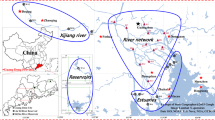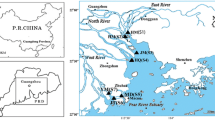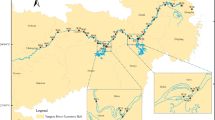Abstract
The occurrence and spatial distribution of 22 congener phthalate esters (PAEs) in the Lanzhou section of the Yellow River were investigated using water and sediment samples collected from 12 stations along the river in August 2016 to March 2017. PAEs were determined by liquid–liquid extraction and gas chromatography–mass spectrometry. The average concentrations of PAE in the water samples during the dry and wet periods were 3236.0 ng/L and 2300.0 ng/L, and the average dry and wet periods of the PAEs in the sediments were 4238.9 ng/g and 3959.9 ng/g, respectively. PAEs were detected in all sampling sites. The six PAEs controlled by the United States Environmental Protection Agency (U.S. EPA), namely dimethyl phthalate (DMP), diethyl phthalate (DEP), dibutyl phthalate (DBP), di-2-ethylhexyl phthalate (DEHP), di-n-octyl phthalate (DNOP), and butyl benzyl phthalate(BBP), were detected. DMP, DEP, DBP, and DEHP accounted for more than 70% of all PAEs. In view of time distribution, PAEs concentration in the water samples of the dry season were greater than those of the wet season, but the sediments did not differ remarkably across the different periods. As for spatial distribution, the PAEs initially exhibited low concentrations in the upper reaches, high concentrations in the middle part, and low concentrations in the downstream; a health risk assessment of the six PAEs controlled by the U.S. EPA was carried out according to priority. Results showed that the carcinogenic risk value was less than 10−6, and the values of the non-carcinogenic compound risk index were less than 1, indicating the absence of carcinogenic damage to organisms or humans.



Similar content being viewed by others
References
Adeogun AO, Ibor OR, Omogbemi ED, Chukwuka AV, Adegbola RA, Adewuyi GA, Arukwe A (2015) Environmental occurrence and biota concentration of phthalate esters in Epe and Lagos Lagoons, Nigeria. Mar Environ Res 108:24–32
Amir S, Hafidi M, Merlina G, Hamdi H, Jouraiphy A, Gharous ME, Revel JC (2005) Fate of phthalic acid esters during composting of both lagooning and activated sludges. Process Biochem 40:2183–2190
Bello UM, Madekurozwa MC, Groenewald HB, Aire TA, Arukwe A (2014) The effects on steroidogenesis and histopathology of adult male Japanese quails (Coturnix coturnix japonica) testis following pre-pubertal exposure to di(n-butyl) phthalate (DBP). Comp Biochem Physiol Part C 166:24–33
Berman T, Hochnercelnikier D, Calafat AM, Needham LL, Amitai Y, Wormser U, Richter E (2011) Phthalate exposure among pregnant women in Jerusalem, Israel: results of a pilot study. Environ Int 37:198–203
Brandes, R., B. Newton, M. Owens & E. Southerland (1991) Draft technical support document for water quality-based toxics control. Bytes,
Cai QY, Mo CH, Wu QT, Zeng QY (2008) Polycyclic aromatic hydrocarbons and phthalic acid esters in the soil-radish (Raphanus sativus) system with sewage sludge and compost application. Bioresour Technol 99:1830–1836
Cheng Z, Nie XP, Wang HS, Wong MH (2013) Risk assessments of human exposure to bioaccessible phthalate esters through market fish consumption. Environ Int 58:75–80
Fan W, Xia X, Sha Y (2008) Distribution of phthalic acid esters in Wuhan section of the Yangtze River, China. J Hazard Mater 154:317–324
Fernández MA, Gómara B & González MJ. 2012. Occurrence of phthalates and their metabolites in the environment and human health implications. Springer Berlin Heidelberg
Fromme H, Kűchler T, Otto T, Pilz K, Műller J, Wenzel A (2002) Occurrence of phthalates and bisphenol A and F in the environment. Water Res 36:0–1438
Guven KC, Coban B (2013) Phthalate pollution in fish Sarda sarda, Engraulis encrasicolus, Mullus surmuletus, Merlangius merlangus and shrimp Parapenaeus longirostris. J Black Sea/Mediterr Environ 19:185–189
Hamidin N, Yu QJ, Connell DW (2008) Human health risk assessment of chlorinated disinfection by-products in drinking water using a probabilistic approach. Water Res 42:3263–3274
Heudorf U, Merschsundermann V, Angerer J (2007) Phthalates: toxicology and exposure. Int J Hyg Environ Health 210:623–634
Hines CJ, Hopf NB, Deddens JA, Silva MJ, Calafat AM (2011) Estimated daily intake of phthalates in occupationally exposed groups. J Expo Sci Environ Epidemiol 21:133–141
Howdeshell KL, Rider CV, Wilson VS, Gray LE Jr (2008) Mechanisms of action of phthalate esters, individually and in combination, to induce abnormal reproductive development in male laboratory rats. Environ Res 108:168–176
Huang PC, Tien CJ, Sun YM, Hsieh CY, Lee CC (2008) Occurrence of phthalates in sediment and biota: relationship to aquatic factors and the biota-sediment accumulation factor. Chemosphere 73(4):539–544
Kimber I, Dearman RJ (2010) An assessment of the ability of phthalates to influence immune and allergic responses. Toxicology 271:73–82
Kong S, Ji Y, Liu L, Chen L, Zhao X, Wang J, Bai Z, Sun Z (2012) Diversities of phthalate esters in suburban agricultural soils and wasteland soil appeared with urbanization in China. Environ Pollut 170:161–168
Li T, Yin P, Zhao L, Wang G, Yu QJ, Li H, Duan S (2015) Spatial-temporal distribution of phthalate esters from riverine outlets of Pearl River Delta in China. Water Sci Technol 71:183–190
Li B, Liu R, Gao H, Tan R, Zeng P, Song Y (2016a) Spatial distribution and ecological risk assessment of phthalic acid esters and phenols in surface sediment from urban rivers in Northeast China. Environ Pollut 219:409
Li X, Yin P, Zhao L (2016b) Phthalate esters in water and surface sediments of the Pearl River estuary: distribution, ecological, and human health risks. Environ Sci Pollut Res 23:19341–19349
Li R, Liang J, Duan H, Gong Z (2017a) Spatial distribution and seasonal variation of phthalate esters in the Jiulong River estuary Southeast China. Mar Pollut Bull 122:38–46
Li R, Liang J, Gong Z, Zhang N, Duan H (2017b) Occurrence, spatial distribution, historical trend and ecological risk of phthalate esters in the Jiulong River, Southeast China. Sci Total Environ 580:388–397
Li Z, Chang F, Shi P et al (2012) Occurrence and potential human health risks of semi-volatile organic compounds in drinking water from cities along the Chinese coastland of the Yellow Sea[J]. Chemosphere, 206:655–662
Liu H, Liang H, Liang Y, Zhang D, Wang C, Cai H, Shvartsev SL (2010) Distribution of phthalate esters in alluvial sediment: a case study at JiangHan plain, Central China. Chemosphere 78:382–388
Mackintosh CE, Maldonado JA, Ikonomou MG, Gobas FAPC (2006) Sorption of phthalate esters and PCBs in a marine ecosystem. Environ Sci Technol 40:3481
Matsumoto M, Hirata-Koizumi M, Ema M (2008) Potential adverse effects of phthalic acid esters on human health: A review of recent studies on reproduction. Regul Toxicol Pharmacol 50:37–49
Net S, Delmont A, Sempéré R, Paluselli A, Ouddane B (2015a) Reliable quantification of phthalates in environmental matrices (air, water, sludge, sediment and soil): a review. Sci Total Environ 515-516:162–180
Net S, Sempéré R, Delmont A, Paluselli A, Ouddane B (2015b) Occurrence, fate, behavior and Ecotoxicological state of phthalates in different environmental matrices. Environ Sci Technol 49:4019–4035
Pei XQ, Song M, Guo M, Mo FF, Shen XY (2013) Concentration and risk assessment of phthalates present in indoor air from newly decorated apartments. Atmos Environ 68:17–23
Sazan P, Karin A, Orna C, Bert-Ove L, Ana PP & Stefania V (2008) European Union Risk Assessment Report - bis (2-ethylhexyl) phthalate (DEHP)
Staples CA, Peterson DR, Parkerton TF, Adams WJ (1997) The environmental fate of phthalate esters : a literature review. Chemosphere 35:667–749
Teil MJ, Blanchard M, Chevreuil M (2006) Atmospheric fate of phthalate esters in an urban area (Paris-France). Sci Total Environ 354:212–223
Vethaak AD, Lahr J, Schrap SM, Belfroid AC, Rijs GBJ, Gerritsen A, Boer JD, Bulder AS, Grinwis GCM, Kuiper RV (2005) An integrated assessment of estrogenic contamination and biological effects in the aquatic environment of The Netherlands. Chemosphere 59:511–524
Vitali M, Guidotti M, Macilenti G, Cremisini C (1997) Phthalate esters in freshwaters as markers of contamination sources—a site study in Italy. Environ Int 23:337–347
Wang W, Zhang Y, Wang S, Fan CQ, Xu H (2012) Distributions of phthalic esters carried by total suspended particulates in Nanjing, China. Environ Monit Assess 184:6789–6798
Wang FM, Li C, Jiao J, Zhang LB, Ya-Qin JI, Bai ZP, Zhang LW, Sun ZR (2012a) Pollution characteristics of phthalate esters derived from household dust and exposure assessment. China Environ Sci 32:780–786
Wang L, Liu M, Tao W, Zhang W, Wang L, Shi X, Lu X, Li X (2018) Pollution characteristics and health risk assessment of phthalate esters in urban soil in the typical semi-arid city of Xi’an, Northwest China. Chemosphere 191:467–476
Yang GCC, Yen CH, Wang CL (2014) Monitoring and removal of residual phthalate esters and pharmaceuticals in the drinking water of Kaohsiung City, Taiwan. J Hazard Mater 277:53–61
Zhang L, Liu J, Liu H, Wan G, Zhang S (2015) The occurrence and ecological risk assessment of phthalate esters (PAEs) in urban aquatic environments of China. Ecotoxicology 24:967–984
Funding
This study was financially supported by the National Natural Science Foundation of China (21667017).
Author information
Authors and Affiliations
Corresponding author
Additional information
Responsible editor: Ester Heath
Publisher’s note
Springer Nature remains neutral with regard to jurisdictional claims in published maps and institutional affiliations.
Electronic supplementary material
ESM 1
(DOCX 24 kb)
Rights and permissions
About this article
Cite this article
Zhao, X., Shen, Jm., Zhang, H. et al. The occurrence and spatial distribution of phthalate esters (PAEs) in the Lanzhou section of the Yellow River. Environ Sci Pollut Res 27, 19724–19735 (2020). https://doi.org/10.1007/s11356-020-08443-7
Received:
Accepted:
Published:
Issue Date:
DOI: https://doi.org/10.1007/s11356-020-08443-7




